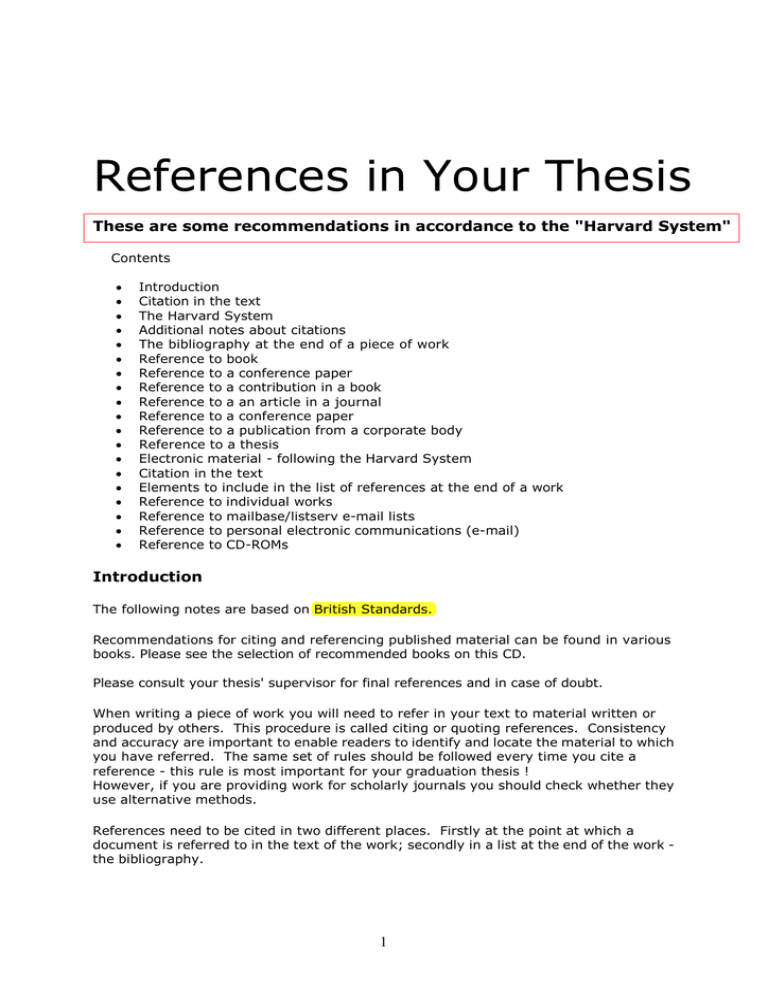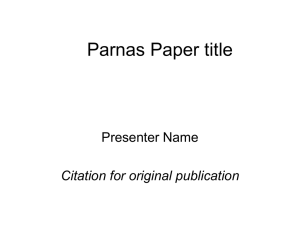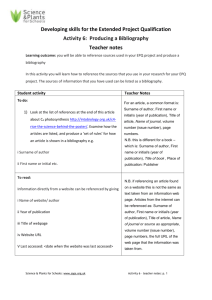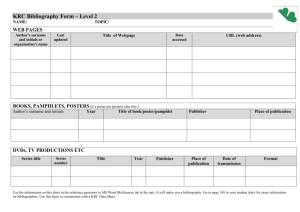References in Your Thesis
advertisement

References in Your Thesis These are some recommendations in accordance to the "Harvard System" Contents • • • • • • • • • • • • • • • • • • • Introduction Citation in the text The Harvard System Additional notes about citations The bibliography at the end of a piece of work Reference to book Reference to a conference paper Reference to a contribution in a book Reference to a an article in a journal Reference to a conference paper Reference to a publication from a corporate body Reference to a thesis Electronic material - following the Harvard System Citation in the text Elements to include in the list of references at the end of a work Reference to individual works Reference to mailbase/listserv e-mail lists Reference to personal electronic communications (e-mail) Reference to CD-ROMs Introduction The following notes are based on British Standards. Recommendations for citing and referencing published material can be found in various books. Please see the selection of recommended books on this CD. Please consult your thesis' supervisor for final references and in case of doubt. When writing a piece of work you will need to refer in your text to material written or produced by others. This procedure is called citing or quoting references. Consistency and accuracy are important to enable readers to identify and locate the material to which you have referred. The same set of rules should be followed every time you cite a reference - this rule is most important for your graduation thesis ! However, if you are providing work for scholarly journals you should check whether they use alternative methods. References need to be cited in two different places. Firstly at the point at which a document is referred to in the text of the work; secondly in a list at the end of the work the bibliography. 1 Citation in the Text The Harvard System (Author-date method) All statements, opinions, conclusions etc. taken from another writer's work should be cited, whether the work is directly quoted, paraphrased or summarised. In the Harvard System cited publications are referred to in the text by giving the author's surname and the year of publication in one of the forms shown below. If details of particular parts of a document are required, e.g. page numbers, they should be given after the year within the parentheses. 1.1 If the author's name occurs naturally in the sentence the year is given in parentheses:e.g. In a popular study Harvey (1992, p.556) argued that ... 1.2 If, however, the name does not occur naturally in the sentence, both name and year are given in parentheses:e.g. More recent studies (Bartlett 1996; James 1998) show that ... 1.3 When an author has published more than one cited document in the same year, these are distinguished by adding lower case letters (a,b,c, etc.) after the year and within the parentheses:e.g. Johnson (1994a) discussed the subject ... 1.4 If there are two authors, the surnames of both should be given:e.g. Matthews and Jones (1993) have proposed that... 1.5 If there are more than two authors the surname of the first author only should be given, followed by et al :e.g. Wilson et al. (1997) conclude that... 1.6 If there is no originator then "Anon" should be used:e.g. A recent article (Anon 1993) stated that... However, if it is a reference to newspapers where no author is given the name of the paper can be used in place of author or Anon whichever seems most helpful. You will need to use the same style in the reference list so the name of the newspaper may be more helpful. e.g. The Times (1996) stated that.... 1.7 If you refer to a source quoted in another work you cite both in the text:e.g. A study by Smith (1960 cited Jones 1994 p.24) showed that... (You need to list the work you have used, i.e. Jones, in the main bibliography. Also: be very careful in these types of quotes !) 2 1.8 Quotations:A short quotation of less than a line may be included in the body of the text in quotation marks but if it is longer start a new line and indent it. Include the page number if desired. Use quotes scarcely! e.g.: .... so "good practices must be taught" (Smith 2004, p.15) and we should... or: 1.9 Theory rises out of practice, and once validated, returns to direct or explain the practice. (Stevens 2003, p.92). Diagrams:Diagrams should be referenced as though they were a quotation with the author and date given alongside and full details in the list of references. Additional notes about citations: 1.0 Personal communications:Taken from : APA, 2003. Publication Manual of the American Psychological Association. 3rd ed. Washington: APA. They do not provide recoverable data and so are not included in the reference list. Cite personal communications in the text only. Give initials as well as the surname of the communicator and provide as exact a date as possible. e.g. Many designers do not understand the needs of disabled people according to J. O. Reiss (personal communication, April 18, 2004). The bibliography at the end of a piece of work The term bibliography describes references to cited documents given in a list at the end of the text. These are usually described as bibliographic references. (In some departments the bibliography is called a references list and there is a separate bibliography of works that have been read but not cited.) In the Harvard System, the references are listed in alphabetical order of authors' names. If you have cited more than one item by a specific author they should be listed chronologically (earliest first), and by letter (2003a, 2003b) if more than one item has been published during a specific year. Whenever possible, elements of a bibliographical reference should be taken from the title page of the publication. Each reference should use the elements and punctuation given in the following examples for the different types of published work you may have cited. 3 Reference to a book Elements to cite: • e.g. Author's SURNAME, INITIALS., Year of publication. Title. Edition. (if not the first). Place of publication: Publisher. MERCER, P.A. AND SMITH, G., 2004. Private viewdata in the UK. 2nd ed. London: Longman. Reference to a contribution in a book Elements to cite: • e.g. Contributing author's SURNAME , INITIALS., Year of publication. Title of contribution. Followed by In: INITIALS. SURNAME, of author or editor of publication followed by ed. or eds if relevant. Title of book. Place of publication: Publisher, Page number(s) of contribution. BANTZ, C.R., 2004. Social dimensions of software development. In: J.A. ANDERSON, ed. Annual review of software management and development. Newbury Park, CA: Sage, 502-510. Reference to an article in a journal Elements to cite: • e.g. Author's SURNAME, INITIALS., Year of publication. Title of article. Title of journal, Volume number and (part number), Page numbers of contribution. EVANS, W.A., 2004. Approaches to intelligent information retrieval. Information processing and management, 7 (2), 147-168. 4 Reference to a conference paper Elements to cite: • e.g. Contributing author's SURNAME, INITIALS., Year of publication. Title of contribution. Followed by In: INITIALS. SURNAME, of editor of conference proceedings (if applicable) followed by ed. or eds. Title of conference proceedings including date and place of conference Place of publication: Publisher, Page numbers of contribution. SILVER, K., 2004. Electronic mail: the new way to communicate. In: D. I. RAITT, ed. 9th international online information meeting, London 3-5 December 2003. Oxford: Learned Information, 323-330. Reference to a publication from a corporate body (e.g. a government department or other organisation). Elements to cite: • e.g. NAME OF ISSUING BODY, Year of publication. Title of publication . Place of publication: Publisher, Report Number (where relevant). UNESCO, 2004. General information programme and UNISIST. Paris: Unesco, (PGI-93/WS/22). Reference to a thesis Elements to cite: • e.g. Author's SURNAME, INITIALS., Year of publication. Title of thesis. Designation, (and type). Name of institution to which submitted. AGUTTER, A.J., 2004. The linguistic significance of current British slang. Thesis (PhD). Edinburgh University. 5 Electronic material - following the Harvard System. No standard method for citing electronic sources of information has yet been agreed upon. The recommendations in this document follow the practices most likely to be adopted and are intended as guidance for those needing to cite electronic sources of information now. Those intending to use such citations in papers submitted to scholarly journals should check whether an alternative method is used by that journal. This section taken from: Holland, M. (1996). Harvard system [online]. Bournemouth University. Available from: http://www.bournemouth.ac.uk/service-depts/newlis/LIS_Gen/cit ation/harvardsystint.html [15 Apr 2004]. Citation in the Text Follow the author, date procedure specified above. Elements to include in the list of references at the end of a work 2.1 Reference to individual works Author/editor. (Year). Title [online]. (Edition). Place of publication, Publisher (if ascertainable). Available from: URL [Accessed Date]. e.g Holland, M. (1996). Harvard system [online]. Poole, Bournemouth University. Available from: http://www.bournemouth.ac.uk/service-depts/lis/LIS_Pub/harvard syst.html [Accessed 15 Apr 2004]. Library Services. (2004). Internet user glossary [online]. North Carolina, North Carolina State University. Available from: gopher://dewey.lib.ncsu.edu:70/7waissrc%3A/.wais/Internet-user -glossary [Accessed 15 Apr 2004]. 2.2 Reference to E-Journals Author. (Year). Title. Journal Title [online], volume (issue), location within host. Available from: URL [Accessed Date]. e.g. Korb, K.B. (2005). Persons and things: book review of Bringsjord on Robot-Consciousness. Psycoloquy [online], 6 (15). Available from: 6 gopher://wachau.ai.univie.ac.at:70/00/archives/Psycoloquy/95.V6 /0162 [Accessed 17 Jun 2005]. 2.3. e.g. Reference to mailbase/listserv e-mail lists Author. (Day Month Year). Subject of message. Discussion List [online] Available from: list e-mail address [Accessed Date]. Brack, E.V. (2 May 2004). Re: Computing short courses. Lis-link [online]. Available from: mailbase@mailbase.ac.uk [Accessed 17June 2004]. Jensen, L.R. (12 Dec 2003). Recommendation of student radio/tv in English. IASTAR [online]. Available from: LISTSERV@FTP.NRG.DTU.DK [Accessed 29 Apr 2004]. It should be noted that items may only be kept on discussion group servers for a short time and hence may not be suitable for referencing. A local copy could be kept by the author who is giving the citation, with a note to this effect. 2.4. Reference to personal electronic communications (E-mail) Sender (Sender's E-mail address). (Day Month Year). Subject of Message. E-mail to Recipient (Recipient's E-mail address). e.g. 2.5. Lowman, D. (deborah_lowman@pbsinc.com). (4 Apr 2004). RE>> ProCite and Internet Refere. E-mail to P. Cross (pcross@bournemouth.ac.uk). Reference to CD-ROMs This section refers to CD-ROMs which are works in their own right and not bibliographic databases. Author/editor. (Year). Title [type of medium CD-ROM]. (Edition). Place of publication, Publisher (if ascertainable). Available from: Supplier/Database identifier or number (optional) [Accessed Date] (optional). e.g. Hawking, S.W. (2004). A Brief history of time: an interactive adventure [CD-ROM]. Crunch Media. 7




